
Morning glory is the common name for over 1,000 species of flowering plants in the family Convolvulaceae, whose current taxonomy and systematics are in flux. Morning glory species belong to many genera, some of which are:

Ipomoea is the largest genus in the flowering plant family Convolvulaceae, with over 500 species. It is a large and diverse group with common names including morning glory, water convolvulus or kangkung, sweet potato, bindweed, moonflower, etc.

Ipomoea alba, sometimes called the tropical white morning-glory or moonflower or moon vine, is a species of night-blooming morning glory, native to tropical and subtropical regions of the New World, from northern Argentina north to Mexico and Florida. Though formerly classified as genus Calonyction, species aculeatum, it is now properly assigned to genus Ipomoea, subgenus Quamoclit, section Calonyction.

Calystegia sepium is a species of bindweed, with a subcosmopolitan distribution throughout the temperate Northern and Southern hemispheres.

Ipomoea purpurea, the common morning-glory, tall morning-glory, or purple morning glory, is a species in the genus Ipomoea, native to Mexico and Central America. Like all morning glories the plant entwines itself around structures, growing to a height of 2–3 metres tall. The leaves are heart-shaped and the stems are covered with brown hairs. The flowers are trumpet-shaped, predominantly blue to purple or white, and 3–6 centimetres (1.2–2.4 in) diameter.

Ipomoea quamoclit is a species of vine in the genus Ipomoea native to tropical regions of the New World and naturalized elsewhere in the tropics.
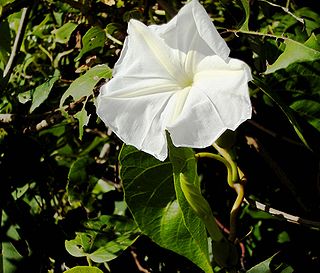
Ipomoea violacea is a perennial species of Ipomoea that occurs throughout the world with the exception of the European continent. It is most commonly called beach moonflower or sea moonflower as the flowers open at night.

Ipomoea pes-caprae, also known as bayhops, beach morning glory or goat's foot, is a common pantropical creeping vine belonging to the family Convolvulaceae. It grows on the upper parts of beaches and endures salted air. It is one of the most common and most widely distributed salt tolerant plants and provides one of the best known examples of oceanic dispersal. Its seeds float and are unaffected by salt water.
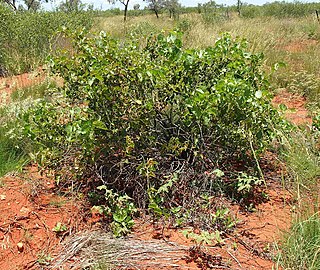
Ipomoea costata, commonly known as rock morning glory, is an Australian native plant. It is found in northern Australia, from Western Australia, through the Northern Territory, to Queensland.
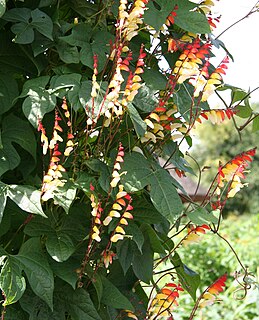
Ipomoea lobata, the fire vine, firecracker vine or Spanish flag, is a species of flowering plant in the family Convolvulaceae, native to Mexico and Brazil.

Ipomoea pandurata, known as man of the earth, wild potato vine, manroot, wild sweet potato, and wild rhubarb, is a species of herbaceous perennial vine native to North America. It is a twining plant of woodland verges and rough places with heart-shaped leaves and funnel-shaped white flowers with a pinkish throat. The large tuberous roots can be roasted and eaten, or can be used to make a poultice or infusion. When uncooked, the roots have purgative properties.

Ipomoea nil is a species of Ipomoea morning glory known by several common names, including picotee morning glory, ivy morning glory, and Japanese morning glory. It is native to most of the tropical world, and has been introduced widely.

Ipomoea triloba is a species of Ipomoea morning glory known by several common names, including littlebell and Aiea morning glory. It is native to the tropical Americas, but it is widespread in warm areas of the world, where it is an introduced species and often a noxious weed. This is a fast-growing, vining, annual herb producing long, thin stems with ivy-like, petioled, heart-shaped leaves 2.5–6 centimetres (0.98–2.36 in) long. The leaves sometimes, but not always, have three lobes. The vines produce tubular bell-shaped flowers, each about two centimeters long. They are quite variable in color, in shades of pink, red or lavender, with or without white markings.

Ipomoea carnea, the pink morning glory, dhol kolmi in Bengali, is a species of morning glory. This flowering plant has heart-shaped leaves that are a rich green and 6–9 inches (15–23 cm) long. It can be easily grown from seeds which are toxic and it can be hazardous to cattle; the toxicity is related to the swainsonine produced by endophytes and to bioaccumulation of selenium species in leaves but mostly in seeds

Ipomoea lacunosa, the whitestar, white morning-glory or pitted morningglory, is a species that belongs to the genus Ipomoea. In this genus most members are commonly referred to as "morning glories". The name for the genus, Ipomoea, has root in the Greek words ips and homoios, which translates to worm-like. This is a reference to the plant's vine-like growth. Lacunosa comes from a Latin word meaning air spaces, correlating with the venation of the leaves. Ipomoea lacunosa is native to the United States and grows annually. The flowers of this species are usually white and smaller than most other morning glories.
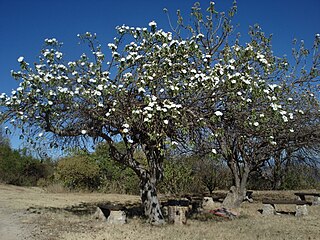
Ipomoea arborescens, the tree morning glory, is a flowering plant coming from the family Convolvulaceae. It grows fast and produces semi succulent stems. This tropical plant is mostly found in Mexico. It flowers in late autumn and winter. Its common name in Nahuatl is Cazahuatl or Cazahuate.
Ipomoea tastensis is a plant species native to the Mexican state of Baja California Sur. They are particularly abundant in the Sierra El Taste, where the white showy flowers make them a conspicuous part of the landscape.

Ipomoea oenotherae is a species of plant of the morning glory genus, Ipomoea, in the family Convolvulaceae. It derives its name from the resemblance it bears to plants in the genus Oenothera. Ipomoea oenotherae is a succulent and a cryptophyte.

Ipomoea pes-tigridis is a species of Ipomoea and family Convolvulaceae. It is known as tiger's footprint. The species is distributed in Asia, Africa, Australia and other islands in the Pacific. It grows in roadsides and sea coasts which sea level is between 0 and 400 m.
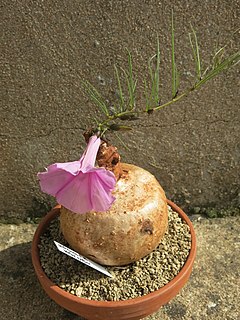
Ipomoea holubii is a species of flowering plant in the family Convolvulaceae.

















